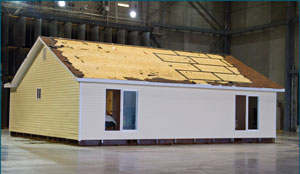The insurance Institute for Business & Home Safety (IBHS) Research Center is a unique, state-of-the-art, multihazard-applied research facility in Chester County, S.C. The facility, which opened in October 2010, enables researchers to more fully and accurately evaluate various residential and commercial construction materials and roof systems.
In August 2011, IBHS conducted a full-scale study of wind-driven, water-penetrating openings in residential roof systems. The study offered an opportunity to gain insight into roof and ventilation system wind-driven water entry issues. The study modeled real-world, post-event damage assessments in areas where hurricane winds were strong enough to rip off roof coverings but not strong enough to blow off roof sheathing.
Why study hurricanes?
During hurricanes and strong wind events, significant property damage and extended occupant displacement routinely occur because of water intrusion. In addition to wind-driven water pouring in—or being blown through—seams between roof sheathing elements when the primary roof covering is damaged and underlayment is lost, water intrusion through residential roof systems can originate from attic ventilation elements, such as ridge, gable-end and soffit vents. This type of damage particularly is common in inland areas where hurricane-strength winds occur but building codes and standards are not as stringent as in coastal jurisdictions.
For example, in 2005, Hurricane Wilma crossed the southern tip of Florida as a Category 2 hurricane with peak wind-speed gusts of 110 mph, causing more than $10 billion in damage. A large portion of the damage occurred inland and was related to roof system damage and resulting water intrusion. Other hurricanes also have caused catastrophic damage as they moved well inland. After Hurricane Ike made landfall in Texas in 2008, it remained strong for two days and generated wind-speed gusts in excess of 70 mph as far inland and north as Ohio, resulting in more than $1.5 billion in losses.
Water penetration can extensively damage interior finishes, furnishings and other contents and lead to ceiling collapse when insulation is saturated. Also, where power is lost and/or a house cannot otherwise be dried out quickly, mold growth is common. IBHS believes the tremendous human and financial costs associated with water penetration during hurricanes could be reduced substantially through widespread adoption of relatively simple, inexpensive changes to residential roof systems, such as sealing roof decks.
Research objectives
Objectives for IBHS' first wind-driven water research program included:
- Quantifying the relative volume of water that penetrated through different roof decks and other selected attic vent systems
- Cataloging types of water penetration damage to different parts of a house
- Evaluating the effectiveness of individual damage mitigation techniques, such as sealing roof decks
The building specimen designed and constructed for the demonstration was a duplex on which half the sheathing joints on the roof deck were sealed before roofing materials were installed; the other half was not sealed. Both roof halves then were covered with felt underlayment before asphalt shingles were installed. The building included gable ends fitted with gable-end vents and 1-foot-wide soffits at the eaves. The roof sheathing stopped short along the primary ridge, so it was possible to install a ridge vent during one set of tests.
All these features have been addressed in the IBHS FORTIFIED Home™ bronze designation, which incorporates current best practices in a systems-based approach to reduce water entry-related losses during high-wind events. The recommendations also are incorporated in IBHS' Roofing the Right Way guide.
The basic recommendations in the IBHS FORTIFIED Home bronze designation and IBHS' Roofing the Right Way guide related to preventing or reducing wind-driven water entry include:
- Sealing the roof deck (joints or the entire surface) to prevent water from running into the attic through the gaps between roof sheathing panels
- Ensuring soffit panels are sufficiently attached to the house so they do not blow off during high winds, thereby creating an opening through which wind-driven water could enter the attic
- Covering gable-end vents with flat shutter panels (plywood or other flat material) before an approaching hurricane to prevent water from being blown into the attic
- Ensuring ridge vents have been tested and approved for resisting wind-driven water entry and are adequately attached using manufacturers' recommendations for high-wind installations
The study gave IBHS its first opportunity to capture high-definition photos and videos during the test to illustrate the relative success and importance of taking these steps to reduce the potential for water entry into attic spaces. Researchers obtained quantitative measurements of water entry during the tests to provide preliminary measurements and insight into the water entering an attic through vents and between sheathing joints.
Measuring water entry rates
When the duplex was constructed, drainage panels and tracks were installed to create water collection channels between ceiling trusses as shown in Photo 1. These channels were outfitted with drains and pipes that allowed collected water to be captured in plastic containers arranged throughout the interior (non-attic) space in the two halves of the duplex.
The drainage system was installed in a modular system that allowed water collection in ceiling areas roughly 10 feet long by 2 feet wide. The trusses ran from the front to the back of the house, and the 22 1/2-inch space between trusses was divided into three sections, each about 10 feet long. Each drainage channel directed water to a separate numbered plastic container. Typical drain and collection locations are shown in Photos 2 and 3. Tests typically were conducted for a 20-minute period during which a constant wind speed was maintained and rainfall rate was set to produce horizontally driven rain on the test building at 8 inches per hour. At the completion of each test, water in the buckets was measured and quantity recorded.
Quantitative test program
The first test sequence involved measuring water entry rates when the soffit cover was missing along the eave. The opening of about 8 1/2 square feet under the eave where wind and wind-driven rain could enter the attic caused by the missing soffit is typical of the observed loss of the soffit cover in strong winds. Tests were conducted at wind speeds of 30 mph, 50 mph and 70 mph during which the wall with the open soffit faced the wind flow. A quartering wind test (where the wall with the open soffit is oriented at 45 degrees off perpendicular to the wind direction) also was conducted at a 50-mph wind speed.
The second test sequence involved repeating the soffit tests with a typical perforated vinyl soffit panel installed so water entry for typical soffits that remain undamaged versus soffit material blown off during an event could be compared. Tests were conducted at 50 mph and 70 mph with the soffited wall facing the wind; a quartering wind test also was conducted at 50 mph.
The third test sequence focused on measuring water entry through the gable-end vent. These tests were conducted with winds at 30 mph and 50 mph, and soffits were covered with typical perforated vinyl soffit panel material.
Following the soffit and gable end quantification test series, the asphalt composition shingle roof covering on the front of the duplex was blown off using high winds. Similar efforts were started for the roof surface at the back of the duplex when a fan drive fault ended wind generation for that day. Because of schedule constraints, the asphalt composition shingle roof covering on the rear of the duplex was manually removed. After removal of the roof covering, a Florida Building Code High-Velocity Hurricane Zone-approved ridge vent was installed.
The final quantification testing sequence evaluated water entry through the sealed and unsealed roof decks at a wind speed of 50 mph (Photo 4). This configuration put the exposed sealed and unsealed roof decks perpendicular to the wind-driven rain to allow a relative comparison in the amount of water entry in the attic for each roof half.
Quantitative test results
The results for the open soffit tests (simulating soffit material loss during a high-wind event) were as follows:

Photo 4: Back of duplex after the unsealed roof deck (left) and sealed roof deck (right) were subjected to 50-mph winds |
- A wind speed of 30 mph produced a light sprinkling of drops on the water collection drainage pans within 8 feet of the open soffit. However, no water trickled down the drainage system to collection buckets.
- A wind speed of 50 mph produced an overall water entry rate into the attic of about 1.3 inches per hour based on the open soffit area. This is about 15 percent of the 8-inch-per-hour rainfall rate being deposited on the adjacent (vertical) wall's surface. Most water was within 10 feet of the attic space adjacent to the open soffit.
- A wind speed of 70 mph produced an overall water entry rate into the attic of about 2.9 inches per hour based on the soffit's open area. This is slightly more than 33 percent of the deposition rate on the adjacent wall's surface.
- A quartering wind of 50 mph produced an uneven distribution of water in the attic but still resulted in about 1.6 inches per hour based on the soffit's open area. This is about 20 percent of the deposition rate on a wall surface that would have been facing the wind flow.
The covered soffit tests (where soffit material remains in place) were as follows:
- A wind speed of 50 mph resulted in water accumulation in the attic space of about 6 percent of the water that entered during the same test for the open soffit case.
- A wind speed of 70 mph produced about nine times more water accumulation in the attic than the test at 50 mph. This was about 25 percent of the water that entered the attic during the same test (70 mph) for the open soffit case.
- A quartering wind of 50 mph produced little water accumulation in the attic. The amount was about 2.5 percent of the water entering during the same test for the open soffit case.
For winds 30 mph and stronger, the water entry rate through the gable-end vent was about equal to the wind-driven water deposition rate on the wall based on the gable-end vent area—almost all water that impacted the vent entered the attic. The relatively small vent surface area limited the total amount of water entering the attic.
The sealed roof deck side (where joints between the roof sheathing were sealed by applying self-adhering polymer-modified bitumen tape) experienced about one-third the water entry experienced on the side without tape. The amount of water entry through the roof deck was more than three times the water that entered through the open soffit. The roof deck test had to be stopped after 16 minutes because the 3-gallon containers were overflowing.
Some water entry on the sealed roof side was caused by cuts in the tape that occurred when the roof covering was removed. Even holes left by the nails pulled out when the roof covering was removed led to steady drips of water into the attic. On the side where the roof covering was blown off (see Photo 5), nails tended to stay in place, which would have reduced nail-hole drips. Use of ring shank nails to fasten shingles and underlayment likely would help reduce these leaks because they would be less likely to pull out even if the shingles blew off.
Water leakage through the Florida Building Code High-Velocity Hurricane Zone-approved ridge vent was not observed.
Consequences of water entry
Following quantitative testing, water-collection devices were removed from the structure, and the holes made in the ceiling for water collection were patched. Furniture was placed in the duplex to replicate actual living spaces. The finished structure then was subjected to a series of wind-driven rain events modeled after Hurricane Dolly. These tests gave IBHS the opportunity to illustrate the consequences of water entry into attic spaces with compelling photos and video. Photo 6 shows water entry through recessed lighting in the kitchen.
The amount of water entering the living space during the demonstration in the duplex's unsealed roof deck side and the level of damage ultimately experienced on this duplex half are typical of the level of water entry reported during real-world events. Within 45 minutes of the test's conclusion, the kitchen ceiling in the duplex's unsealed side collapsed as shown in Photo 7. Shortly thereafter, the living room area ceiling also collapsed.
Following the test, IBHS brought in an experienced property insurance claims adjuster to estimate the amount of damage sustained to each duplex side. He assessed damage to the front three rooms on both sides of the duplex, including the kitchen, dining and family rooms. During a hurricane or high-wind event, winds generally come from a relatively small range of directions, so damage confined to one area of a house would be typical.
The difference between estimated repair costs of the two duplex sides was substantial. The loss estimate for the side without a sealed roof deck was more than three times the loss estimate for the side with the sealed roof deck. Of particular note: The furniture in the side without a sealed roof deck required replacement, but furnishings in the side with the sealed roof deck only required cleaning.
Recommendations
These preliminary tests demonstrate the areas addressed in the IBHS FORTIFIED home programs and Roofing the Right Way guide are important to reducing water entry during hurricanes and other storms where wind-driven rain is a factor. Clearly, sealing roof decks is one of the most important protective measures that can be undertaken. However, roofing contractors should be careful to make sure seams are sealed securely and drip edges are attached using typical high-wind requirements for fasteners. It is likely the Florida Building Code High-Velocity Hurricane Zone requirements for applying roofing cement around roof edges also would help reduce water entry if a roof covering sustains damage during a storm.
As a preliminary study, this work suggests much more investigation is needed to quantify the amount of water entry that can be expected for typical construction, how much water entry is likely to be reduced with various water entry prevention measures and how much water entry can be tolerated before costs of water entry remediation become unacceptable.
Steve Quarles, PH.D., is senior scientist for the Insurance Institute for Business & Home Safety.



